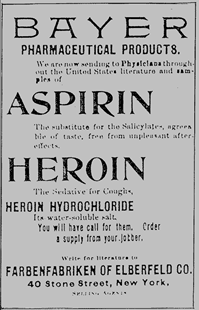 Allied troops in Afghanistan are celebrating a heroin bust reputed to be one of the biggest ever: Approximately 92 tons of street-ready horse, along with several tons more of “processing chemicals.”
Allied troops in Afghanistan are celebrating a heroin bust reputed to be one of the biggest ever: Approximately 92 tons of street-ready horse, along with several tons more of “processing chemicals.”
Given our nerdly inclinations, our first thought upon learning of this seizure was, “Why no details on those chemicals?” Because the unsung villain in the heroin trade is acetic anhydride, a compound widely used in the production of film coating, aspirin, and treated lumber. It’s also key to turning morphine into heroin, and has been since C.R. Wright first synthesized the drug 135 years ago.
The problem for Afghan heroin labs is that no acetic anhydride is manufactured in the country. And so thousands of tons of the stuff must be smuggled in, as surely as thousands of tons of heroin are annually smuggled out. A by-the-numbers breakdown from last year:
Acetic anhydride is the essential precursor used for converting opium into morphine base and heroin. It looks and smells a lot like vinegar. Its sole use in Afghanistan is in drug refineries that have increased their annual demand from about 200 tons to 1,330 tons during the last six years.
None of the precursors are manufactured in Afghanistan. In all, some 11,000 tons of chemicals were required to process opium in Afghanistan during 2007.
The chemicals are smuggled into Afghanistan from China, India, Pakistan, and the Central Asian Republics. Sometimes they’re labeled as cleaning solutions or industrial chemicals, but most of the time they’re simply trucked into Afghanistan without inspection or detection on either side of the border. There have been no significant seizures of precursor chemicals in any of the countries bordering Afghanistan since 2001. The lack of seizures during the last two years, when record levels of Afghan opium and heroin were being produced, is especially troubling.
“Over 1,000 tons of acetic anhydride is needed to process all of this opium into heroin,” said Hakan Demirbuken, regional monitoring expert with the United Nations Office on Drugs and Crime (UNODC). “Last year more than 90 percent of the precursor seizures were at the eastern part of Afghanistan in the provinces of Nangarhar, Khost, and Paktya near the Pakistan border.” There are virtually no seizures across the border, in spite of the fact that the majority of precursor chemicals arrive by way of Pakistan.
India, in particular, appears to be the hot new source for acetic anhydride. International law enforcement has been trying to restrict the trade in the chemical, but might a newish, cold-temperature production method foil their best-laid plans?


Jordan // May 28, 2009 at 10:50 am
When you’re talking about restricting drug production, dealing with synthetic precursors seems much more effective than dealing with simple plant-based derivatives. This is why we’ve actually had some amount of success in reducing the supply of methamphetamine in America. Each time a source of ephedrine or pseudoephedrine is lost to the manufacturers of methamphetamine, supply drops precipitously. For a while. Unfortunately for me this means that it’s nearly impossible to get pseudoephedrine over the counter anymore, which is a right pain during cold season.
On another note, it’s a bummer that the only way I’m likely to be able to read the full version of that article is a work. Which would probably set off some kind of alarm.
“No officer, I swear I just find organic synthesis methods fascinating!”
Brendan I. Koerner // May 28, 2009 at 11:08 am
@Jordan: Amazing how much impact the whole “let’s put the cold medicine behind the counter” approach had on domestic meth production. The flip side, I guess, is that it simply made it a more lucrative market for Mexican traffickers, which has led to some, uh, problems along the border.
But the approach would strike me as potentially even more effective for heroin, since production can’t be so fluid (due to its crop-dependent nature). Then again, the “leaky” part of the equation seems to the Pakistan border; good luck increasing enforcement along there.